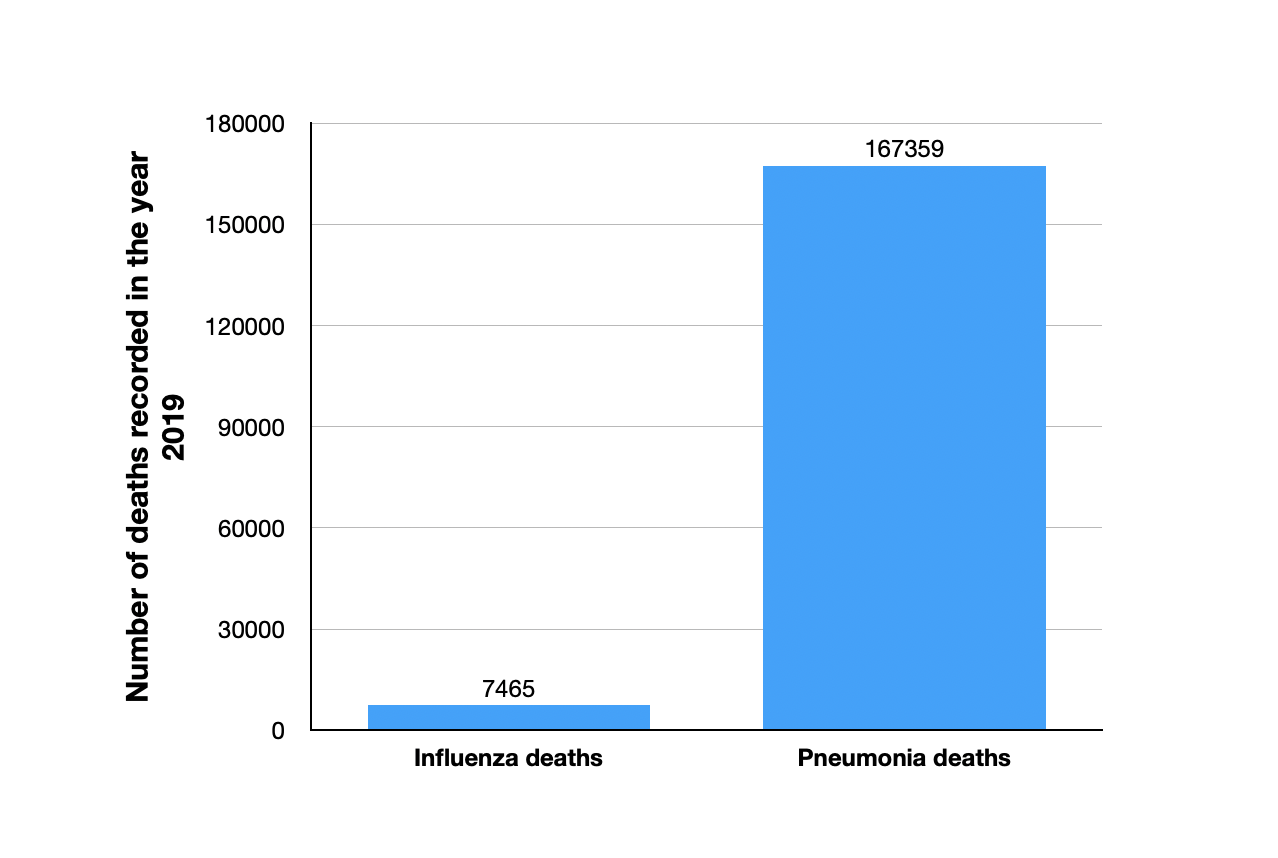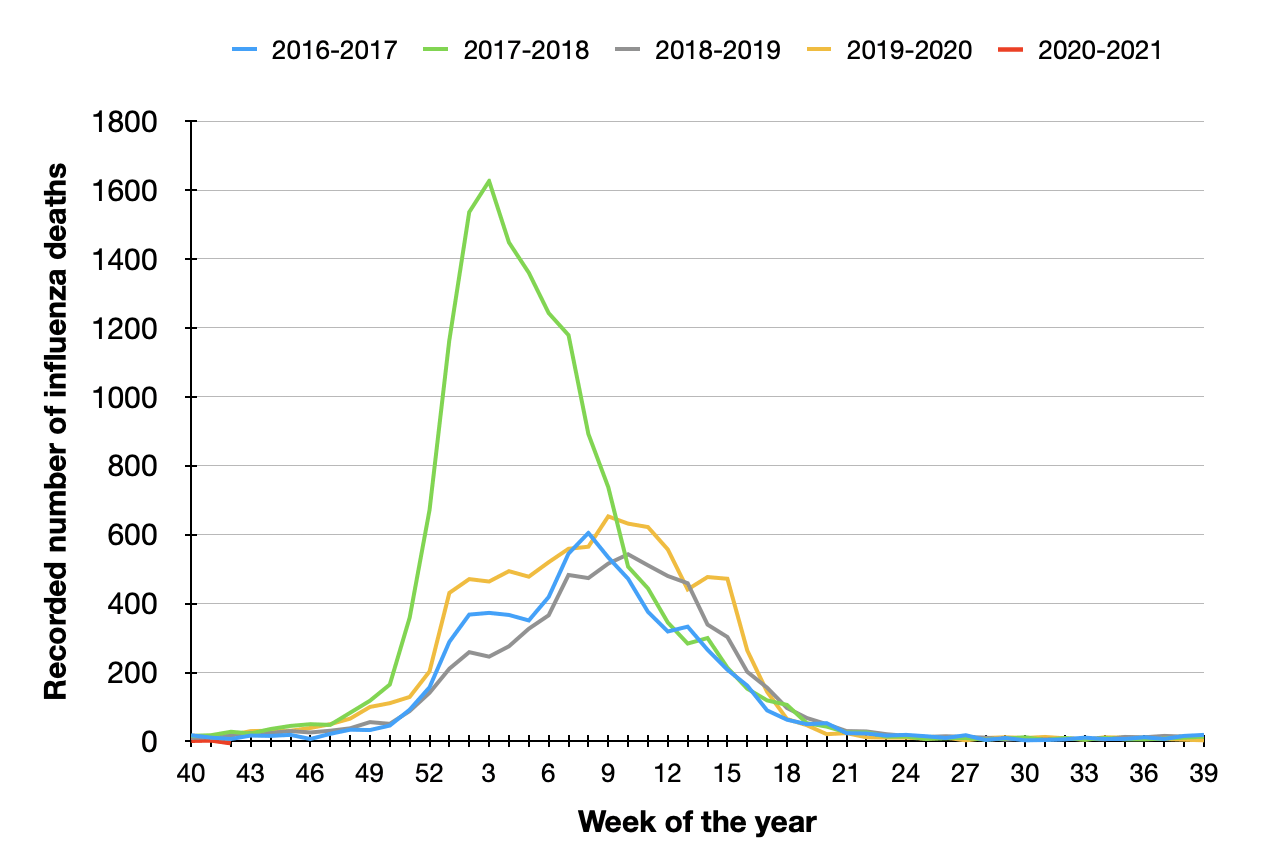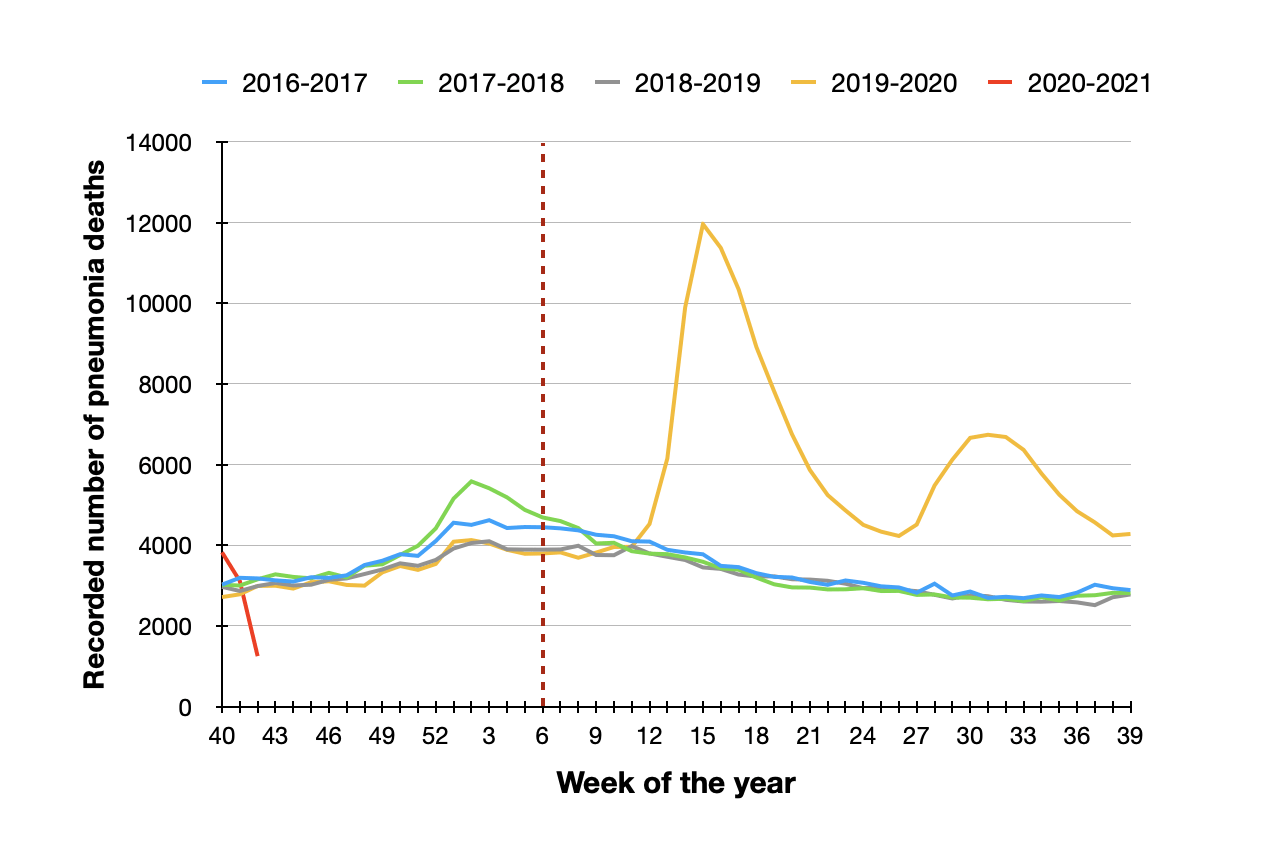
Misleading: At the time of the claim, the 2020-2021 flu season only just began. It is difficult to accurately estimate the number of flu deaths for the current season, as these do not become apparent until later in the season. Since the data was incomplete at the time of the claim, the comparison of flu deaths for this season with that of last year is misleading.
Inadequate support: Trump Jr. provides no evidence for the hypothesis that flu statistics are being manipulated in “allocation games.”

FULL CLAIM: “We went from 75,000 flu deaths last year in America to almost 0. Does anyone actually believe that? Or do you think there may be allocation games being played to manipulate the truth?”
REVIEW
The COVID-19 pandemic introduces an element of uncertainty regarding the dynamics of this year’s flu season. Although scientists expressed concerns about the simultaneous occurrence of the pandemic and the flu, they also observed a curious phenomenon—flu activity so far this season is lower than that of previous years. Flu activity is based on the percentage of patient samples that test positive for influenza as reported by clinical laboratories.
This observation led others to claim that the relatively fewer number of flu cases seen thus far is the result of data manipulation, which this Health Feedback review previously analyzed and found to be unsupported by scientific evidence. On 26 October 2020, Donald Trump Jr. made a similar claim on Twitter, alleging that “We went from 75,000 flu deaths last year in America to almost 0. Does anyone actually believe that? Or do you think there may be allocation games being played to manipulate the truth?” This was retweeted more than 26,000 times at the time of this review’s publication.
The provenance of the number cited by Trump Jr. is unclear. The U.S. Centers for Disease Control and Prevention (CDC) estimated 21,909 flu deaths during the 2019-2020 flu season, which is more than three times lower than the figure provided by Trump Jr. It is also inconsistent with the CDC’s estimates of flu deaths for the flu seasons during the past decade (see Figure 1 below), although an article published by STAT in June 2019 did report that the CDC estimated about 75,000 deaths in the U.S. from the H1N1 pandemic. The H1N1 swine flu pandemic started in the U.S. in spring 2009, more than a decade ago in 2019. However, the CDC later revised its estimates to almost 12,500 deaths from the H1N1 pandemic for the period between 12 April 2009 to 10 April 2010.

Figure 1. The CDC’s estimates of flu deaths for each season in the past decade. Note that the estimates for the 2017-2018 and 2018-2019 seasons are preliminary and may change when data is finalized. Estimates of flu deaths are calculated based on several parameters, including data from death certificates. Data retrieved from this CDC webpage (archived) on 29 October 2020.
Another interpretation of Trump Jr.’s reference to “last year” may be the number of flu deaths occurring in the calendar year 2019, rather than last year’s flu season which runs from 2019 to 2020. Although deaths are typically reported for a season rather than a calendar year, we explored the possibility that Trump Jr.’s tweet was accurate if it was interpreted to refer to the calendar year 2019. To do this, we examined the number of flu and pneumonia deaths recorded for all the weeks in the year 2019, based on data from the U.S. National Center for Health Statistics (NCHS) on causes of death recorded in death certificates (Figure 2).

Figure 2. Number of deaths for which cause of death was coded as flu or pneumonia in death certificates in the calendar year 2019, as recorded by the U.S. National Center for Health Statistics. The actual figures are provided at the top of each bar. Data retrieved from the U.S. CDC’s FluView Interactive application on 27 October 2020.
As we can see from Figure 2, the recorded numbers for flu deaths, pneumonia deaths, as well as the sum of both, do not support the 75,000 figure cited by Trump Jr.
Next, a comparison of flu deaths between last season and this season at this point in time is spurious, as it is too early in this flu season to obtain an accurate number of flu deaths. Flu is a seasonal disease that typically starts in October, when Trump Jr. tweeted this claim, whose impact only becomes apparent later in the season. As explained by the CDC:
“‘Flu season’ — as determined by elevated flu activity – also varies from season to season. During most seasons, activity begins to increase in October, most often peaks between December and February and can remain elevated into May. The flu season is said to have started after consecutive weeks of elevated flu activity is registered in the various CDC influenza surveillance systems.”
Indeed, Trump Jr.’s tweet was published during week 44 of the year (26 October to 1 November). Epidemiological data from the past four flu seasons shows that recorded flu deaths, based on death certificates listing the cause of death as flu and/or pneumonia, do not begin increasing until weeks 46 through 49 (see Figures 3 and 4 below). Therefore, contrary to Trump Jr.’s claim, it is not unusual to observe few flu deaths at this point in the flu season.

Figure 3. Number of deaths for which cause of death was coded as flu in death certificates, as recorded by the U.S. National Center for Health Statistics, for this season and the past four seasons. Data retrieved from the U.S. CDC’s FluView Interactive application on 27 October 2020. Note that data for the 2020-2021 season (red line) is incomplete and may be lower than the number of actual deaths as the season has only just started and aggregating mortality data takes time (see limitations).

Figure 4. Number of deaths for which the cause of death was coded as pneumonia in death certificates, as recorded by the U.S. National Center for Health Statistics, for this season and the past four seasons. Data retrieved from the U.S. CDC’s FluView Interactive application on 27 October 2020. The red dotted line marks the week when the first COVID-19 death occurred in the U.S. in February 2020. The higher level of pneumonia deaths observed during the 2019-2020 season correspond to the COVID-19 pandemic. Note that data for the 2020-2021 season (red line) is incomplete and may be lower than the number of actual deaths as the season has only just started and aggregating mortality data takes time (see limitations).
Readers may observe that the number of flu deaths based on death certificates (Figure 2) are much smaller than the CDC’s estimates (Figure 1). This is because the estimates correct for underreporting of flu deaths. The CDC explains:
“Why doesn’t CDC base its seasonal flu mortality estimates only on death certificates that specifically list influenza?
Seasonal influenza may lead to death from other causes, such as pneumonia, congestive heart failure, or chronic obstructive pulmonary disease. It has been recognized for many years that influenza is underreported on death certificates. There may be several reasons for underreporting, including that patients aren’t always tested for seasonal influenza virus infection, particularly older adults who are at greatest risk of seasonal influenza complications and death. Even if a patient is tested for influenza, influenza virus infection may not be identified because the influenza virus is only detectable for a limited number of days after infection and many people don’t seek medical care in this interval. Additionally, some deaths – particularly among those 65 years and older – are associated with secondary complications of influenza (including bacterial pneumonias). For these and other reasons, modeling strategies are commonly used to estimate flu-associated deaths. Only counting deaths where influenza was recorded on a death certificate would be a gross underestimation of influenza’s true impact.”
Lastly, the implication that a decrease in the number of flu cases or flu deaths observed this season is the result of data manipulation is not credible and unsupported by evidence. In fact, an observed decrease would likely be due, in part, to the implementation of public health measures to reduce the spread of COVID-19. These measures include the use of face masks, physical distancing, and isolation, which likely also limit the spread of flu as both diseases are spread via respiratory droplets. Indeed, the WHO cautioned that:
“The current influenza surveillance data should be interpreted with caution as the ongoing COVID-19 pandemic influenced to varying extents health seeking behaviours, staffing/routines in sentinel sites, as well as testing priorities and capacities in Member States. The various hygiene and physical distancing measures implemented by Member States to reduce SARS-CoV-2 virus transmission have likely played a role in reducing influenza virus transmission.”
In fact, scientists already observed shorter durations of flu activity in various countries around March 2020 during last year’s flu season (2019-2020), a few weeks after public health measures were implemented to reduce the spread of COVID-19. As reported in this Nature news article:
“Seasonal flu cases in the northern hemisphere usually peak in February and tail off by the end of May. This year, unusually, lab-confirmed cases of influenza dropped precipitously in early April, a few weeks after the coronavirus pandemic was declared on 11 March […] The data comes from tests of more than 150,000 samples from national influenza laboratories in 71 countries that report data to FluNet, a global surveillance system.”
Another news article by Science reports a similar phenomenon in countries in the Southern Hemisphere:
“Apparently, travel restrictions, school closures, social distancing, and mask wearing have all but stopped flu from spreading in South Africa. Similar stories have emerged from Australia, New Zealand, and parts of South America.”
This article in the CDC’s Mortality and Morbidity Weekly Report also highlights the same observation[1], but cautions that this phenomenon should not be taken for granted and that preparing for the flu season is still important:
“[I]n light of the novelty of the COVID-19 pandemic and the uncertainty of continued community mitigation measures, it is important to plan for seasonal influenza circulation this fall and winter. Influenza vaccination for all persons aged ≥6 months remains the best method for influenza prevention and is especially important this season when SARS-CoV-2 and influenza virus might cocirculate.”
In summary, the number of flu deaths cited in Trump Jr.’s tweet is inaccurate, as it is three times higher than CDC estimates of flu deaths during last year’s season and is also inconsistent with flu-related deaths recorded for the calendar year 2019. Furthermore, it is premature to make definitive conclusions about the number of flu deaths for this season, as the flu season just started and deaths do not peak until later in the season.
Finally, the suggestion that any observed reduction in the number of flu deaths this season is the result of data manipulation is baseless. Instead, evidence suggests that the lower levels of flu activity observed so far this season is due, in part, to a change in the dynamics of flu activity as a result of public health measures implemented to reduce the spread of COVID-19. This would likely translate to fewer flu-related deaths, although this remains to be confirmed by data.
REFERENCES
- 1 – Olsen et al. (2020) Decreased Influenza Activity During the COVID-19 Pandemic — United States, Australia, Chile, and South Africa, 2020. Mortality and Morbidity Weekly Report.


